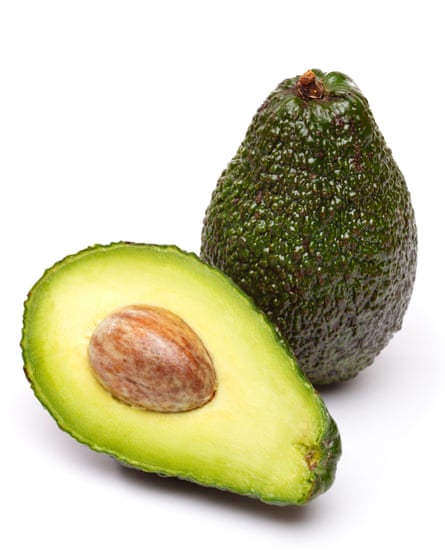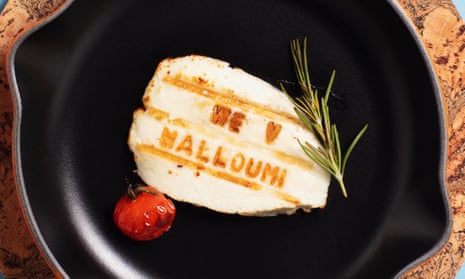Gently, I pull my halloumi from its loose plastic wrapping. I do this delicately, since, like funfair goldfish or those waterproof watches you can buy at the airport, halloumi comes sealed in a bag of liquid, as if the poor cheese was in a rush to reach you and has lost a good part of its weight in sweat. I slice the spongy, cuboid form and let its segments slap and sizzle into the pan, where its edges turn from brilliant, Tipp-Ex white to a golden yellow. The rectangles don’t melt so much as separate at each end, until each resembles something like a chubby letter H, or an artist’s representation of a chromosome.
Halloumi has been a consistent part of my diet for most of the nine years I’ve been in London. Its appeal is in its zesty tang and its odd, formless texture. That tooth-satisfying squish and give that makes it readily applicable to so many methods of cooking; barbecued in strips, cooked with a salad, or positioned as a meat substitute wherever needed.
Alas, there are mounting alarms that the world’s halloumi stocks are now at risk and it turns out, much like that one Joni Mitchell song that predicted the death of parks but not the decline of centralised taxi services, we really don’t know what we’ve got till it’s gone.

“I could see it coming,” Anthony Heard, who is half-Cypriot, tells me. “It’s why I started the business. I could see people getting into it; it was on every supermarket shelf.”
His business is Kupros Dairy, manufacturer of its own halloumi-style cheese, Anglum. Named for its English provenance, it doesn’t actually label itself “halloumi” because, like champagne or cockneys, calling oneself a halloumi requires exacting geographical criteria. At least, that was the case until Cyprus lost the trademark to its name earlier this year, owing to mismanagement of the filings for this registration in the UK – a feat of incompetence which prompted an investigation by the Cypriot Ministry of Energy, Commerce and Tourism, still ongoing. Whatever the legal rubrics, however, the island of Cyprus is still the only place on Earth where “authentic” halloumi can be found, and this small Mediterranean island, with less than a million inhabitants, is tasked with supplying the entire global demand for the un-melting cheese.
And that demand is huge. The past decade has seen it go from being an inside favourite of London’s Cypriot diaspora to a fixture on the menus of Nando’s, Burger King and your barbecue-mad Uncle Gary if he thinks a vegetarian might pop round. It has grown so popular, in fact, that experts warn demand will shortly outstrip supply.
I was brought up on a Northern Irish diet so epicureally indifferent that Babybels were considered a somewhat exotic cheese. My father still talks of the time some Spanish cousins came to visit and could only find olive oil in a pharmacy, where it was kept on hand to unblock ears. This was, he assures me, around 1994 or so. I came to regard halloumi as an intoxicating new delicacy when I moved to London. For Heard and most other London Cypriots, however, halloumi was a constant presence, and one whose bewildering rise to popularity is hard to pinpoint in time.

“When halloumi started coming to the UK market in a bigger way,” he says, “I was like, ‘What the hell is happening?’ It was slightly bizarre because my grandma and my great-grandma sent over little tinfoil wrappers – which I think a lot of Cypriots in London can identify with – filled with cheese, in the post.”
“First time I heard about the shortage was about six months ago,” says chef Selin Kiazim, a north Londoner of Turkish-Cypriot parents, who owns and operates Shoreditch Turkish restaurant Oklava. “It was always a staple at home,” she tells me, “I’d even get annoyed at my mum, opening the fridge saying, ‘Why – why is it always halloumi and no other cheeses?’”
“I feel like it’s always been there,” says Anna Jones, food writer, stylist and vegetarian cook. “The parts of London that I’ve lived in have always had strong Greek and Turkish communities, so there is generally a bit more halloumi in the shops when that’s the case. It was maybe 2005/6 when I remember seeing it around more.”
According to the Cyprus Trade Centre, global halloumi shipments more than doubled in the years between 2013 and 2017, from £66.4 million to £140 million. Of that figure, more than 40% went to the UK, making us by some distance the world’s largest buyer of the cheese. All this before the Chinese struck a deal to start importing it in large quantities themselves last year. This has, necessarily, stretched production on an island of finite resources, and put a spanner in the works of those seeking to make an ordinarily artisanal product to industrial mass-scale specifications.

“My grandmother used to make her own,” says Kiazim, “as I think most grandmothers in Cyprus do. She used to have her own goats and she’d make the most incredible halloumi. Eating it fresh is completely different, but then the way they keep it and the way it ages can make it become quite hard and flavoursome. It was for breakfast, lunch, dinner.”
“The turning-point was in 2014-15,” says Heard, “when Nando’s probably took it over the edge and popularised it. It’s a shame, because what they use isn’t fantastic quality.”
For Heard, a lot of the halloumi that makes it to the UK is unrecognisable from the product he or Kiazim would have seen their grandmothers make, a result of the incentives created for compromising the product in favour of distribution on a mass scale. The demand for halloumi has thus created an industrial form of the cheese, made to lower specifications, and a lower price. This, he claims, simultaneously prices artisanal makers like their ancestors out of the market and floods it with an inferior product.
The history of halloumi’s origin is opaque. Some experts maintain it dates back millennia, although its earliest written description is from a 16th-century account by Venetian doge Leonardo Donà, otherwise famous for being the first person to buy a telescope from Galileo. Unfortunately, it would seem the modern halloumi industry is rather less far-sighted.

“Traditionally,” Heard tells me, “halloumi should be made of 100% sheep’s milk or 100% goat’s milk, or a mixture. Now, almost all the halloumi exported to the UK uses 80% cow’s milk.” The reason for this, he tells me, is fairly simple: cows are just much, much bigger.
“A cow can produce 30 litres a day, compared with a sheep or goat, which can produce two or three litres maximum. That’s 10 times the quantity per animal and, since the European dairy industry is based on cow’s milk, the price is lower. But the result is worse. Having said that, I never judge anyone for eating that because they can only access the product they can access. My job is to show how good it can be and what it should be.”
Kiazim concurs. “A lot of people call it a ‘squeaky cheese’ and it’s not meant to be squeaky! It’s so versatile.”
Throughout my conversations with experts and writers on the topic, this subject of halloumi’s “squeakiness” recurs, and I find myself drawn to thinking what it is about that texture which I and so many others love, but which others find utterly repugnant. My dad, for example, is fond of claiming that halloumi boasts the consistency and taste of bundled-up balloons.
“I get it” says Anna Jones, “my mum also hates it. She finds the squeaky, waxy texture really off-putting. Anything I make, she pushes the halloumi to the side. I cook with halloumi, and as a vegetarian it’s something I do use, but I think there’s this fascination with it that sometimes I’m not sure I’m 100% behind.”
As the husband of a vegetarian, I mention that it was also nice for my wife to be able to order something in a restaurant, even several somethings, other than mushroom risotto or pasta. That was until, like any oversubscribed choice, it turned into the new ubiquity itself.
“I think it has become almost oversaturated” Jones continues. “It’s become the new stuffed pepper for vegetarians. There are really interesting ways of cooking with it, but the slabs of grilled halloumi, tossed into a salad or put between burger buns? We can do better than that.”
Whether vegetarian or not, for many the choice to consume more halloumi is borne of ethical considerations, be that eating less meat, or diversifying their diets away from foodstuffs considered harmful or industrially manufactured. Does the fact that this now threatens to destabilise an island economy, and industrialise a once artisanal product, seem doubly ironic? As with recent worries over quinoa, palm oil or avocados, can one ever consume ethically under capitalism or should we all just build allotments, eat wasps and die face down in our own dirt?
“People say things like that,” says food writer Jonathan Nunn, “as if it’s the end-point and there’s no point trying. We need to start thinking about our consumption to make food systems fairer. We should try to limit our consumption of endangered or unethically sourced foods, have conversations on fast food that are not just about health but about workers on poverty wages, talk about palm oil but also acknowledge how culturally important it is in West African cuisines.”
“Everything in moderation,” says Kiazim. “I think the problem is that the lovely British public get a bit fixated on the next thing, and I think that’s what halloumi has become.”
Perhaps a little bit of scarcity might push us back on the road to moderation, or prompt a resurgent black market of Cypriot grannies offloading tinfoil in north London speakeasies. Or maybe this will simply spell the end of Britain’s love affair with the small white blobs gently sizzling in my pan. Not for me, though, and not any time soon.
More food under fire
Other fashionable favourites that have come under threat

Coconuts More than 100 products are made from coconut, and its oil and water have surged in popularity. But the trees that grow it are increasingly senile and experts say the only answer is cloning.
Avocados have spurred a million jokes about millennials – but the world may be spared their further wrath as recent bad crops have left the supply faltering and prices rising, as demand continues to thrive.
Hummus The future of chickpeas hangs in the balance, partly due to massive demand and also because of their versatility – who knew chickpea water made the perfect vegan meringue? Last year, drought in India created a global shortage.
Quinoa may be a good reverse-case study. Its popularity was once decried as a threat to the Peruvian ecosystem, raising prices above a manageable level for local people. But subsequent reports have shown the high price improved the welfare of poor rural communities, whose dependence on the grain for personal use was also widely overstated.
Follow Séamas on Twitter @shockproofbeats

Comments (…)
Sign in or create your Guardian account to join the discussion